Isabella I la Catolica: the infanta becomes queen
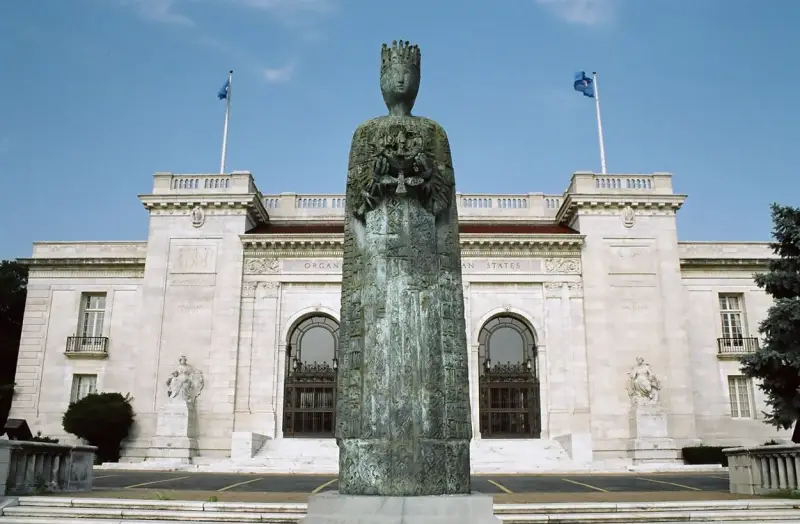
Monument to Isabella I at the Pan American Union building of the Organization of American States, Washington
В previous article we talked about the childhood and youth of the Catholic Queen Isabella of Castile, her origins, her mother’s severe mental illness, provincial life in Arevalo, where her confessor and teacher was the famous Tommaso Torquemada, who at that time was the rector of the Monastery of the Holy Cross in Segovia. Today we will continue this story.
Infanta Isabella gets married
Isabella, who, like the completely different Alienor of Aquitaine, took part in military campaigns and rode horseback, is described as a short and not very slender girl with white skin, greenish-gray eyes and golden hair.
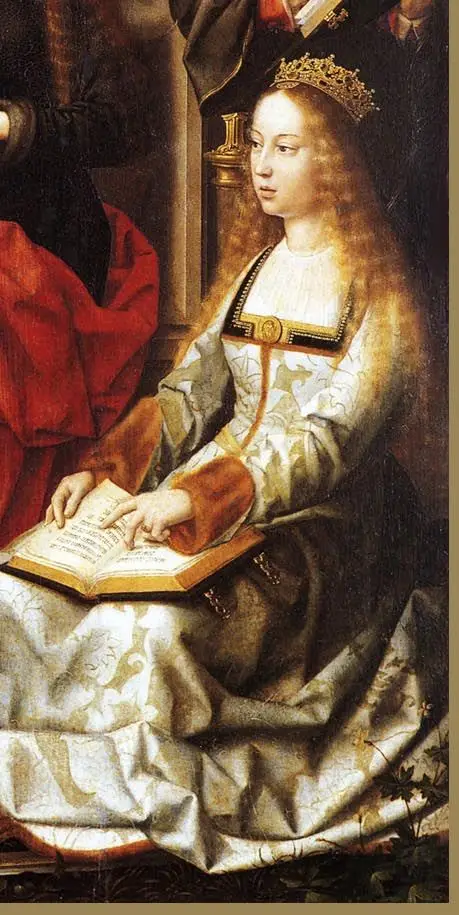
Portrait of the young Isabella of Castile, Santa María la Mayor Collegial Church, Toro, Spain
Note that blond hair in Spain and Italy was a sign of aristocratic origin. Blonde commoners were considered bastards, some of them invented their own pedigree and made a good career in the royal service or at the court of the largest feudal lords.
Italian women, to lighten their hair, doused it with bull urine and sat with their heads open all day in the sun. The result was a golden-red hue, now known as “Titian” - because women with such hair can often be seen in the paintings of this artist.
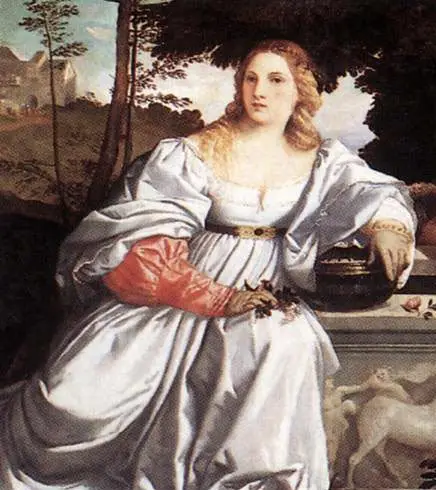
Fragment of Titian’s painting “Earthly Love and Heavenly Love”
In Spain, the inhabitants of Asturias, who all considered themselves nobles, were traditionally proud of their blond hair and blue blood (the fact that blue veins are visible on the white skin of their hands). You can read about this in Cervantes’s novel Don Quixote, in the episode where the Asturian woman, the innkeeper’s maid, promised to come to a certain driver at night:
But let's return to the young Infanta Isabella.
After 7 years in Arevalo, King Enrique IV ordered her and her younger brother Alfonso to return to court. Many believe that he did this out of fear of a conspiracy in their favor - he decided to keep his relatives under supervision.
By this time (in 1462), the second wife of this king, Joao of Portugal, gave birth to a daughter, Juana. Almost no one believed in the legitimacy of her origin, since the queen was suspected of having a connection with Beltran de la Cueva - and therefore the girl received the contemptuous nickname Beltraneja.
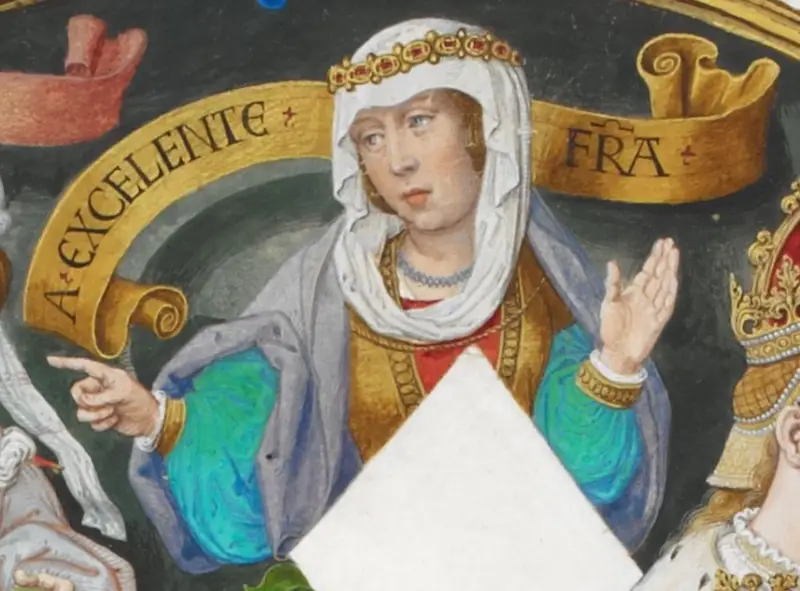
Juana of Castile (Beltraneja) in the portrait of António de Holanda
For some reason, Infanta Isabella was forbidden to sit at the royal dinner table, and as a sign of protest, her brother Alfonso and the Archbishop of Toledo refused a seat next to the king.
Meanwhile, the Spanish aristocrats forced Enrique to bequeath the throne to his half-brother Alfonso, son of Isabella of Portugal, who entered history under the nickname "Rival". However, there were dissatisfied people who bet on Juana.
In 1465, some Spanish grandees openly opposed the king and even burned his effigy (this incident went down in history as the “Avila booth” or “farce”). Juan Pacheco, Marquis de Villena, to the sound of trumpets and drums, read out to the people a list of charges of 45 points: among other things, the “defendant” was accused of impotence and inclination to homosexuality. The Archbishop of Toledo removed the crown from the effigy and announced the deposition of Enrique IV, after which Count Miranda threw the chair to the ground.
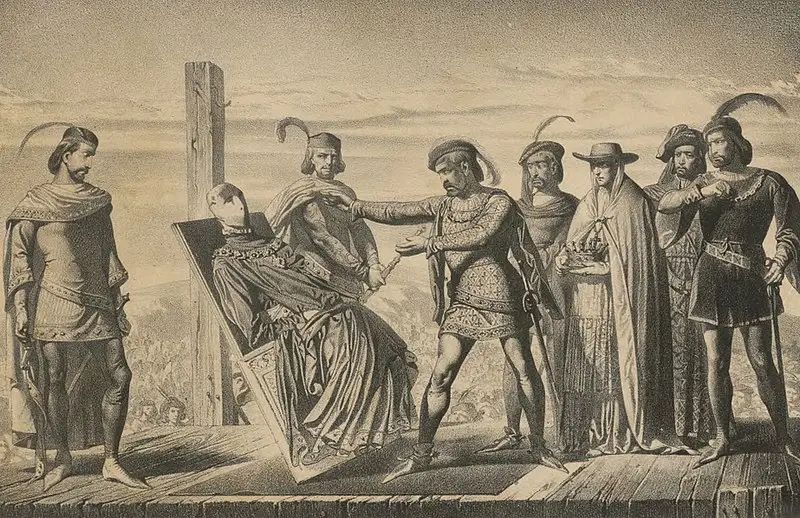
Marcelino de Unceta y Lopez. Atentado de Avila
Isabella's younger brother, who rose to the dais, was proclaimed King of Castile and Leon Alfonso XII - and he was recognized by the northern provinces of the country. But the southern provinces supported Enrique IV.
The 14-year-old applicant died suddenly (apparently, he was poisoned), and then in 1468 the parties came to a compromise: King Enrique IV gave Isabella the title of Princess of Asturias and declared her his heir. An agreement was reached that she would not marry without Alfonso's consent, and he would not force his half-sister into an unwanted marriage. He divorced Joanna of Portugal, and her daughter Juana was excluded from inheritance.
Isabella categorically rejected her brother's proposal to marry the old King of Portugal Alfonso V, but the candidacy proposed by Torquemada and the Toledo Archbishop Alfonso Carrillo de Acuña completely satisfied her, although the groom was a year younger than her, and also a relative - a second cousin brother
Isabella's future husband's name was Ferdinand (Hernando), he was the son of King Juan of Aragon and was considered the governor of Catalonia.
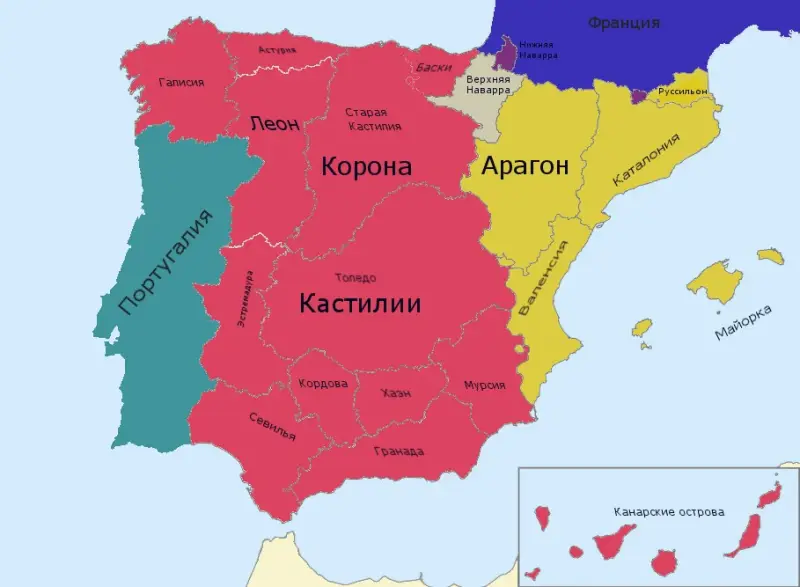
Castile, Leon, Aragon (after completion of the Reconquista)
The future Catholic kings belonged to the Trastámara dynasty, whose representatives at different times ruled in Castile, Aragon, Leon, Sicily, Naples and Navarre. Isabella's grandfather Enrique III of Castile and Ferdinand's grandfather Ferdinand I of Aragon were siblings.
Even before his marriage to Isabella, her fiance managed to have two illegitimate children. Isabella of Castile will become queen 5 years after the marriage, and Ferdinand will ascend to the throne of Aragon, Valencia and Sicily 10 years after the wedding.
King Enrique IV did not give permission for this marriage, but no one was interested in his opinion. Moreover, the God-fearing Isabella so wanted to marry Ferdinand that she was not embarrassed even by the refusal of Pope Paul II to issue a bull of permission, which was applied for by the groom's father Juan II, who, by the way, was called the Great in Aragon, and in Navarre - the Faithless or Treacherous .
The Roman Pontiff's consent to this marriage was fabricated, and the real one was received only after Isabella gave birth to her first child. However, a copy of the authorizing bull was never found in the Vatican archives, so some researchers consider this document to be fake.
Catholic kings
In the summer of 1469, Ferdinand and his entourage arrived in Castile under the guise of merchants, while Isabella left the palace under the pretext of meeting with her mother. The marriage of Isabella and Ferdinand took place on October 19, 1469. Most historians believe that this happened in Valladolid, but some say Segovia.
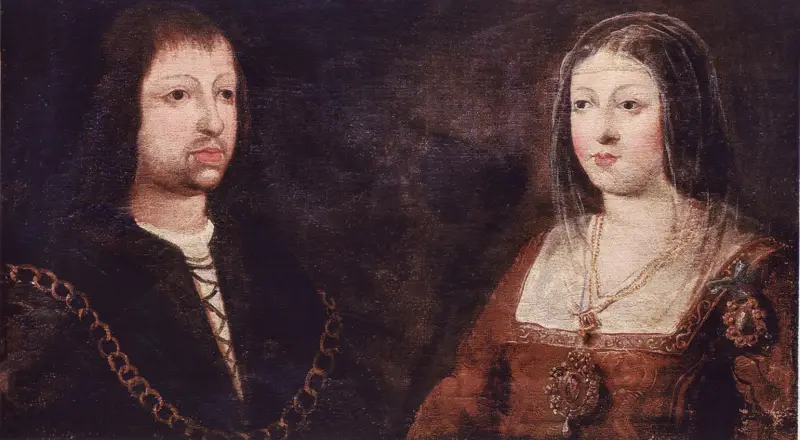
Wedding portrait of Isabella of Castile and Ferdinand of Aragon by an unknown artist
King Enrique IV accused Isabella of violating the treaty and canceled the decision to recognize her as his heir. However, he was soon forced to reconcile with his sister.
And on December 11, 1474, Enrique unexpectedly died, and Isabella, who had many supporters, entered the kingdom of Castile and Leon.
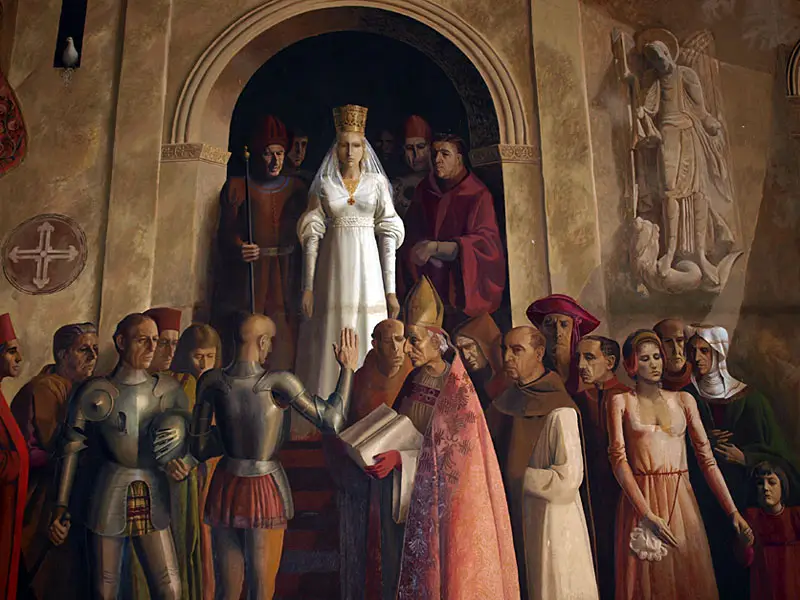
Coronation of Isabella I of Castile. Segovia, Alcazar
It was planned that Ferdinand would limit himself to the role of prince consort, but later he nevertheless became co-ruler with his wife, their names were minted on coins, acts of appointment were issued on behalf of both spouses, and court sentences were pronounced. In 1496, Pope Alexander VI (the second pontiff of the Borgia family) granted the new monarchs the title of Catholic Kings - every person in Spain will immediately understand who we are talking about when they see the word la Catholica next to the name Isabella or Ferdinand.
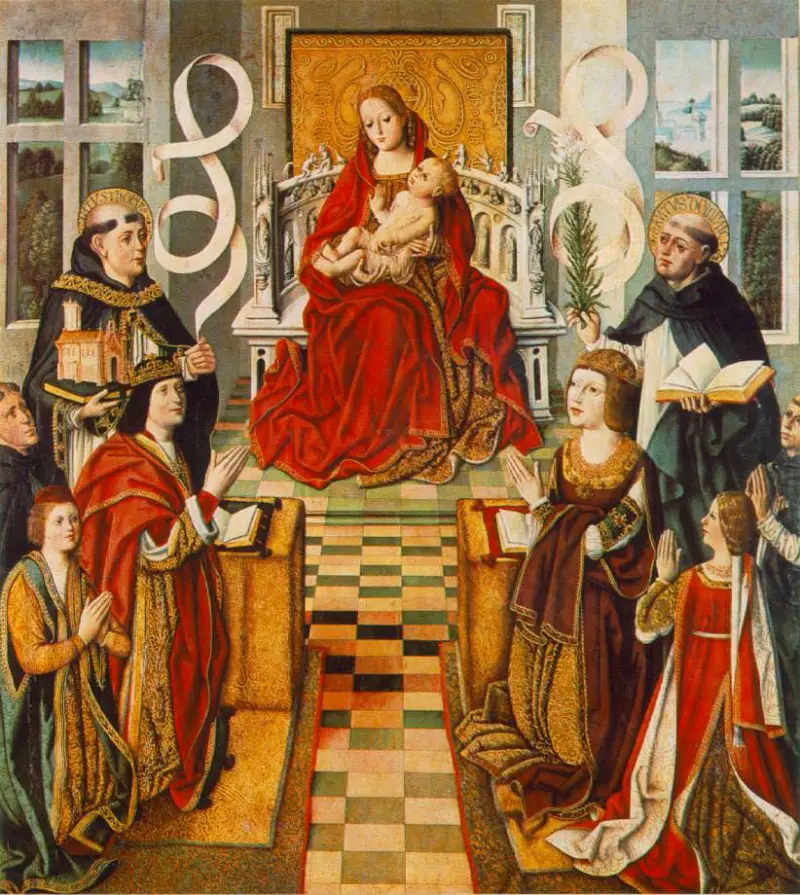
Fernando Gallega, Madonna of the Catholic Kings
The motto of the Catholic kings, which was invented by Antonio de Nebrich, was the phrase Tanto monta, montatanto, Isabel como Fernando (“All the same, Isabella, like Ferdinand”).
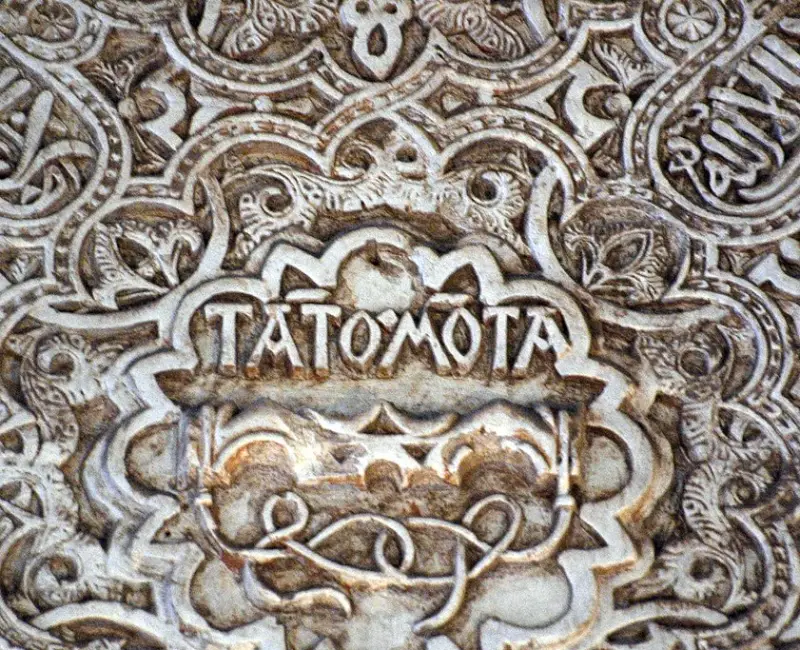
Motto of the Catholic Kings in the Alhambra
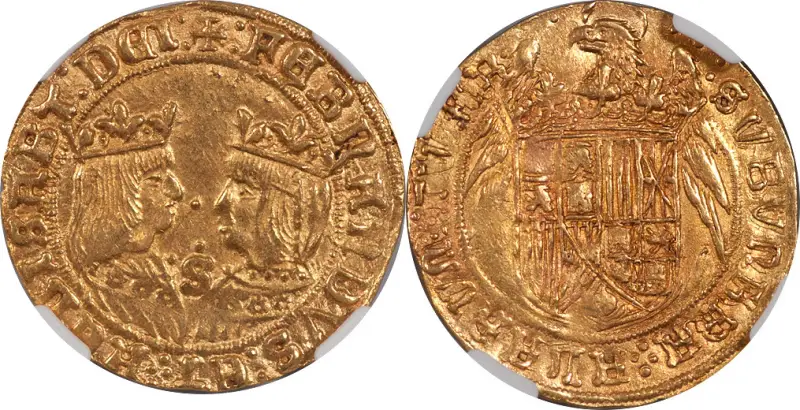
Golden doubloon with the image of Isabella and Ferdinand
However, in Castile, Ferdinand acted only as Isabella's commissioner, the state treasury and the royal army remained under the exclusive control of the queen.
By the way, it was Isabella, as Queen of Castile, who made the decision to finance Columbus’s expedition. Therefore, the Kingdom of Aragon was initially prohibited from maintaining any, especially commercial, relations with the American continent - its sphere of influence remained the Mediterranean.
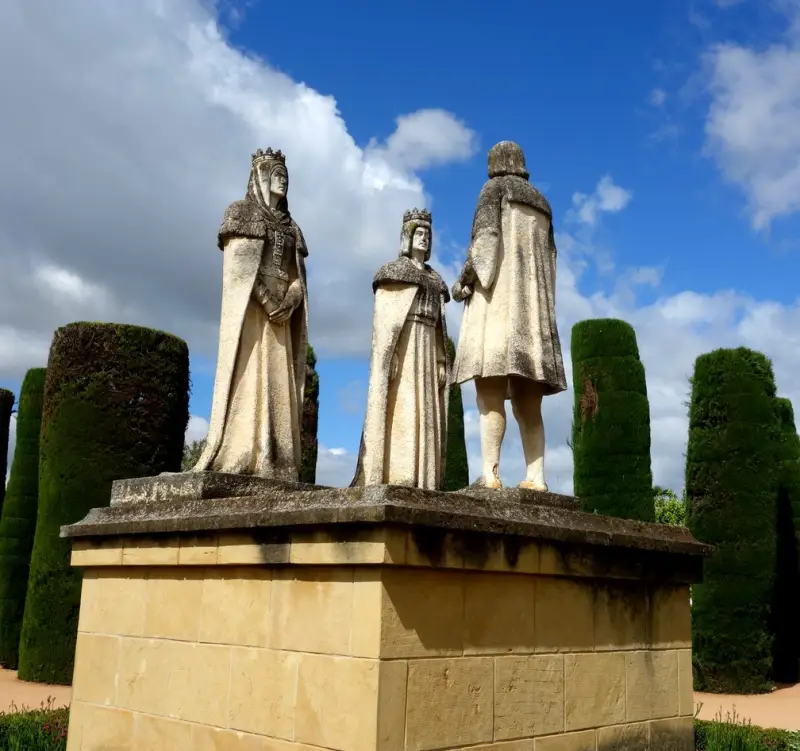
Isabella of Castile, Ferdinand of Aragon and Christopher Columbus. Gardens of the Catholic Kings, Alcazar, Cordoba
Tommaso Torquemada, for his help in organizing the marriage of Isabella and Ferdinand, was offered the position of Archbishop of Seville, which he refused. On his advice, Ferdinand was appointed master of all military-religious orders.
In addition, in addition to the grandees, letrados (scholars, literates) were allowed to govern the state - people from among the petty nobility (hidalgo) and townspeople who received a university education. In 1476, based on the principle of the urban police militia of some Castilian cities in all regions of Castile, Leon and Aragon, the “Saint Hermandade” (from hermandades - “brotherhood”) was formed. You can learn about the authority of this organization and the fear that all criminals felt before it from Cervantes’ novel “Don Quixote” - Sancho Panza says to his master:
“Saint Hermandada” became a pillar of the central government and played a big role in limiting the rights of local feudal lords. In a short time, the fortifications of 50 castles were razed - and the grandees became much more obedient and manageable.
In addition, now all free people were required to purchase weapon, corresponding to their status, keep it “in proper form” and regularly practice handling it. Violators of this decree faced a heavy fine. This is how the personnel reserve of the Spanish army was formed.
Meanwhile, in 1475, the king of Portugal, Alfonso V (Isabella's rejected fiancé), tried to challenge Isabella's right to the throne of Castile and Leon - on the grounds that he was now married to Juana Beltraneja, the daughter of Enrico IV and Joanna of Portugal. The war with Portugal continued until 1479 and ended after Pope Sixtus IV annulled the consanguineous marriage of Alfonso and Juana.
Isabella's 17-year-old niece was forced to go to the monastery of St. Clare in Coimbra), but she often left it for the Lisbon Castle of St. George and signed her letters Yo la reina (“I am the queen”) for the rest of her life. In 1482, she almost married the 15-year-old King of Navarre, Francis Phoebus, but the groom was poisoned.
In the year the war with Portugal ended, Ferdinand's father, Juan II, died. Isabella of Castile now also received the title of Queen of Aragon, Valencia and Sicily, and also became Countess of Barcelona.
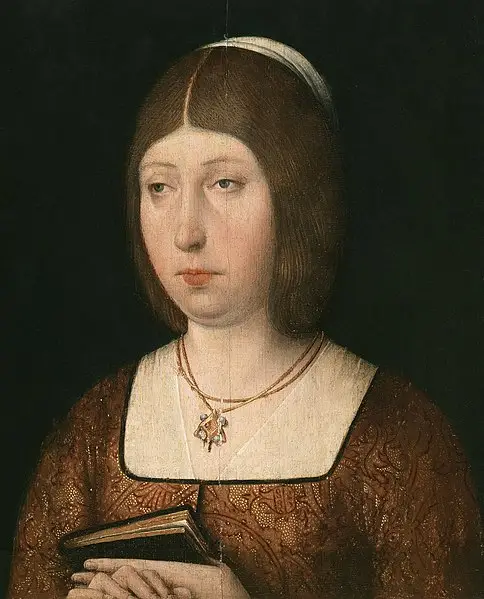
Isabella I, painting by an unknown artist, circa 1490, Prado Museum
Family life and the fate of Isabella's children la Catolica
The marriage of Isabella and Ferdinand turned out to be successful. At first they loved each other very much, and did not part even during military campaigns. Children often accompanied them and were brought up in a very spartan environment: fasting, prayers, the younger daughters wore dresses and shoes for the older ones.
But at the end of her life, the relationship between the spouses cooled significantly (especially after the death of her only son); Isabella spent more time in monasteries than at court. But before that, Isabella gave birth to 7 children, of which only 5 survived. The only son, Juan, was the second child of this couple. He was born in 1478, his portrait can be seen in the painting “Madonna of the Catholic Kings” by Ferdinand Gallego:
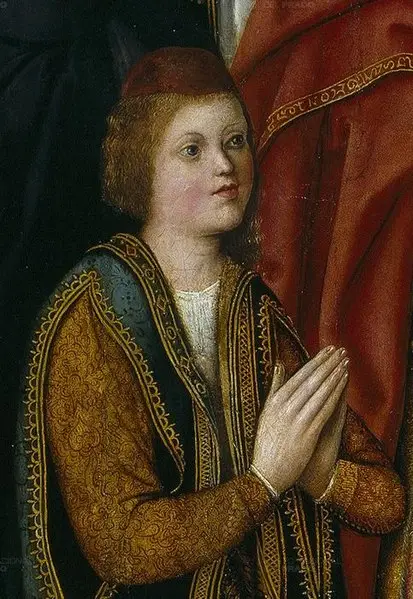
The parents planned to marry their son to the English princess Catherine of York and even to his cousin Juana Beltraneja (who was 16 years older than him!), but in the end a marriage was arranged with the daughter of the Holy Roman Emperor Maximilian I, Margarita. The marriage took place on April 3, 1497, the couple loved each other, but already on October 4, Juan died of some kind of fever, and his wife soon gave birth to a stillborn child. Contemporaries said that
The eldest daughter of the Catholic kings - and the first child of this couple (also Isabella) was born on October 1, 1470.
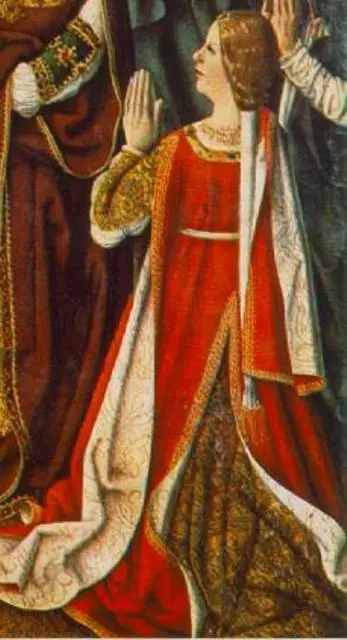
Portrait of the eldest daughter of Isabella and Ferdinan in the painting “Madonna of the Catholic Kings”
During the war with Portugal, a 7-year-old girl unexpectedly found herself captive in the rebellious city of Segovia. After the end of this war, an agreement was reached on her marriage with the grandson of the Portuguese king, who was 5 years younger than her. After spending three years in Portugal, she returned to her homeland and accompanied her parents during the campaigns against Granada.
She married a Portuguese prince in 1490, but just six months later her husband died after falling from a horse - Isabella was sure that the misfortune happened due to the fact that Portugal accepted some of the Jews expelled by her parents from Spain.
Returning home, she declared that she wanted to devote the rest of her life to prayers and self-flagellation, but agreed to become the wife of the new king of Portugal, Manuel I, but only after he promised to expel from the country all Jews who refused to convert to Christianity. It was on the way to this wedding that her older brother Juan fell ill and then died.
The son of Isabella and Manuela, Miguel, became heir to the thrones of Castile and Leon, Aragon and Portugal, but died before he even lived two years - on July 15, 1500. Isabella herself died shortly after his birth.
The new wife of Manuel I was the fourth daughter of the Catholic kings, Maria, who gave birth to 10 children in this marriage, died at 34 and became the mother of King João III of Portugal, as well as the Holy Roman Empress Isabella (wife of Charles V).
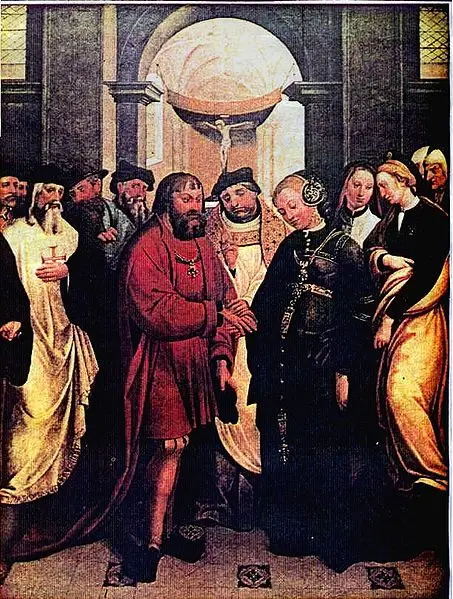
Fernandes Garcia. Betrothal of Manuel I and Infanta Maria
The second daughter (and third child) of Isabella and Ferdinand went down in history as Juana the Mad (we remember that Juana’s grandmother, Isabella of Portugal, also had mental problems, who at the end of her life even stopped recognizing her children).
Juana was born on November 6, 1479, and in 1496 she was married to the Duke of Burgundy, Philip the Fair, who would become the first representative of the Habsburg dynasty on the Spanish throne.
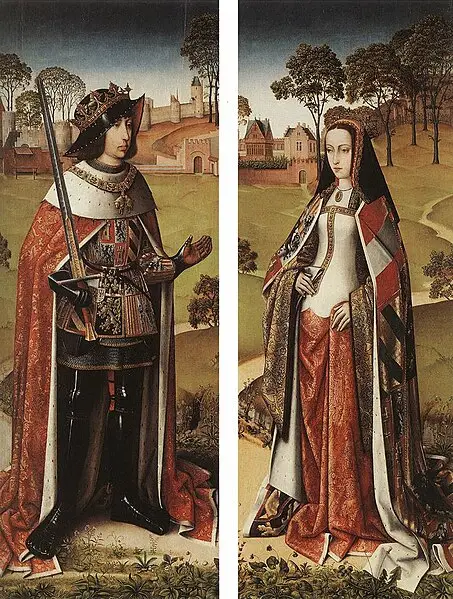
Master of Affligem. Philip the Fair and Joan the Mad in the gardens of the castle of Brussels
It was this daughter of the Catholic kings, after the death of her brother Juan, her elder sister Isabella and her son Miguel, who became the heir to the throne of Castile and Leon. She was proclaimed queen in 1504 after the death of her mother, but even then her mental state was so unstable that her husband was appointed regent for her.
At the same time, Juana’s father, Ferdinand, reproached his son-in-law for usurping the throne, and therefore, after the sudden death of Philip (September 25, 1506), rumors even spread about his poisoning. A legend arose that she, who was in love with her husband Juan, took his body with her everywhere, and even slept with him, but it is known for sure that she transported the coffin of Philip Juan for burial from Burgos to Granada, where the royal tomb was located (but never delivered it) , and it was opened only 4 times in several months.
The queen's madness by that time had become so obvious that her father placed her in a monastery in the city of Tordesillas, where she, formally considered the queen of Castile, lived continuously until her death in 1555. Nevertheless, she gave birth to 6 children (the last girl was already in the monastery).
The eldest daughter, Eleanor, became the third wife of the Portuguese king Manuel I, who had previously been the husband of her two aunts, Isabella and Maria. And her second husband was the King of France Francis I.
Juana's eldest son is the famous Emperor Charles V of Habsburg. His brother Ferdinand, the founder of the Austrian branch of the Habsburgs, during whose reign the Turks were defeated near Vienna, also became Emperor of the Holy Roman Empire.
Daughter Isabella became Queen of Denmark, Norway and Sweden, Maria became Queen of Hungary and the Czech Republic. Born in the monastery, Catherine (Catalina) became Queen of Portugal.
The youngest daughter of the Catholic kings, who went down in history under the name Catherine of Aragon, on November 14, 1501, became the wife of the English Prince Arthur, the eldest son of the English king Henry VII, but her husband died six months later, and due to his young age, he was unable to make the Spanish princess a woman .
Catherine remained in England, in 1507 she received credentials from her father - and found herself in the role of ambassador to the English court. Henry VII wanted to make her his wife, but in the end, shortly before his death, he ordered his son Henry, the one who many would compare with Duke Bluebeard from the French fairy tale, to marry Catherine.
The wedding took place on June 11, 1509. On January 1, 1511, a son, Henry, was born in this marriage, who died on February 22. The next child, daughter Maria, was born only on February 18, 1516. Henry VIII, who wanted to have an heir, asked Pope Clement VII for permission to divorce.
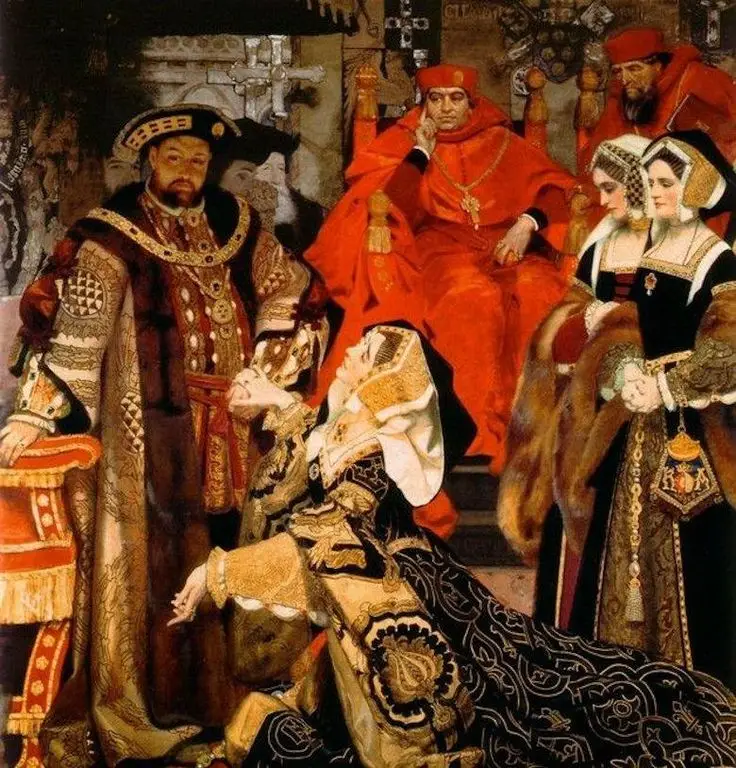
Frank O. Salisbury. Henry VIII and Catherine of Aragon in front of the papal legates in 1529, painting in 1910
The pope's refusal led to the emergence in 1534 of the Anglican Church, the head of which was the English monarchs. Catherine was stripped of her queen status, becoming merely the Dowager Princess of Wales, and her daughter was declared illegitimate.
However, in 1553, Mary Tudor nevertheless ascended to the English throne, and in 1554, after her marriage to Philip II (son of the Holy Roman Emperor Charles V), she also became the Queen of Spain.
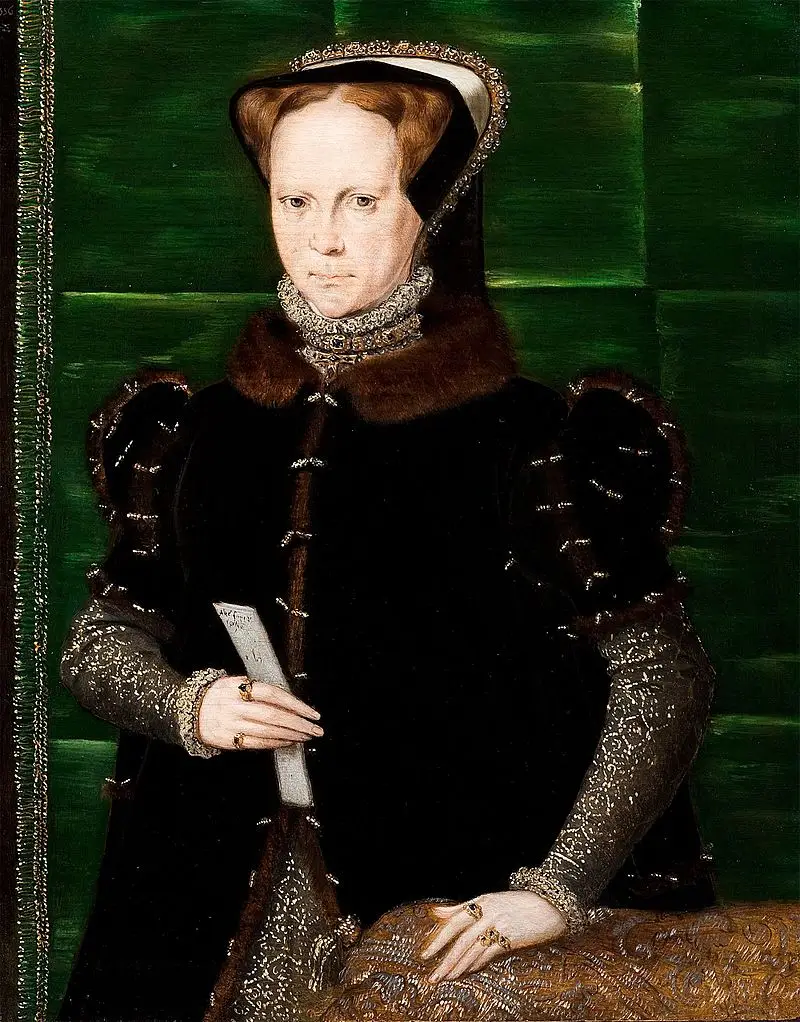
Hans Evort. Portrait of Maria Tudor, 1554
She entered the history of England under the nickname Bloody Mary, reigned for 4 years and died of some kind of fever in 1557, bequeathing the English throne to another girl with a difficult fate - the daughter of Anne Boleyn, the famous Elizabeth I.
In the next article we will continue the story about Isabella I la Catolica, we will talk about the founding of the Inquisition and the expulsion of the Jews.
Information